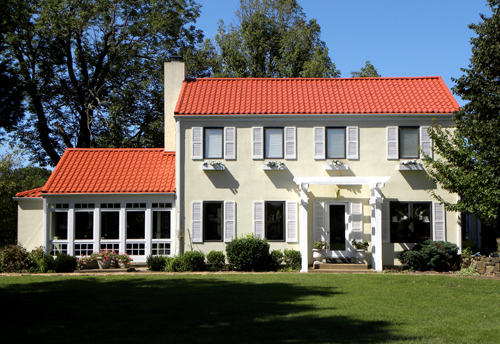Latest Data Shows Jump In Metal Roofing Demand For New Residential Construction
 |
The use of metal roof systems that resemble more traditional types of roofing materials is increasing, according to the Metal Roofing Alliance. Photo courtesy of MRA member ATAS International. |
Portland, OR - The latest industry report for the U.S. residential roofing sector shows that growth for metal roofing for new home construction has doubled in the past year, and continues to enjoy an ongoing steady demand among the repair/remodel market
segment.
According to the recent 2019 Dodge Report data commissioned by the Metal Roofing Alliance (MRA), metal roofing is the second most popular type of residential roofing
in the U.S. For new construction, market share doubled from four percent in 2018 to eight percent in 2019. The repair/remodel market share for metal roofing held steady at 12 percent for 2019.
The MRA attributes the increased demand for metal roofing among U.S. home builders to the adoption of more resilient building products that deliver better, long-lasting performance in climate extremes. The Mid-Atlantic region, where severe storms and
hurricanes are common, saw the greatest increased use of metal roofing. Other factors that have helped boost the popularity of metal roofing include the desire among consumers for more environmentally-friendly choices and greater familiarity and knowledge
of metal roofing.
“Home builders have their finger on the pulse of what today’s homeowners want and the latest trends in the market,” said Renee Ramey, MRA executive director. “As consumers become more educated about their options and gravitate
towards building materials and practices that are resilient, sustainable and long-lasting, we’re seeing that reflected in what builders are choosing to use.”
Other factors driving demand for metal roofing include the increased adoption of residential solar systems and rising popularity of net zero homes. As a stronger, durable and lighter-weight material that lasts for decades, metal is an ideal platform to
outlast residential rooftop solar panels, and can help maximize a home’s energy efficiency to lower utility bills.
Design and style also play a major role in driving the demand for metal roofing. Overall, metal roofing offers more styles, colors and design options than any other type of roofing material. Since 2015, the annual Dodge report has showed an increase in
the popularity of metal roofing styles—including those that mimic shingles, shake, tile and slate—from 22 percent to 34 percent for 2019 in the repair/remodel market. The use of higher end materials such as copper also has increased from
five percent in 2015 to nine percent in 2019.
The research indicates that today’s homeowners also understand the benefits of high-tech metal roofing coatings to boost energy efficiency and deliver low maintenance benefits. While even bare metal roofs are more energy efficient than asphalt,
their use decreased from 32 percent in 2015 to 23 percent in 2019, while the adoption of pre-painted metal roofs jumped from 53 to 61 percent during the same time period for the repair/remodel market. As the industry’s leading resource for driving
metal roofing education and awareness, Ramey says homeowners are increasingly savvy about options that will improve their home’s long-term performance, as well as maximize curb appeal and resell value.
Yet there is still room for improvement. While the 2019 Dodge Report shows the rising popularity of metal roofing, many regions prone to dangers such as wildfire, have been slower to adopt metal roofing even though metal roofs offer a Class A fire rating
and are ignition-resistant to flying embers and sparks. According to the MRA, as knowledge of metal roofing benefits continue to grow, so too will its market share, especially in regions grappling with severe climate threats.
“The need to re-evaluate and do things differently in light of a changing climate will continue to lead homeowners and builders to construct more resilient homes in every region,” said Dick Bus, President of ATAS International and the MRA.
“As an MRA member, our goal is to make sure all homeowners, whether they are replacing their roof or building a new home, have the resources and information they need to make the best choice possible.”
About The Metal Roofing Alliance
 Representing metal roofing manufacturers in the United States and Canada, the Metal Roofing Alliance (MRA) was formed in 1998 as a
nonprofit organization to help educate consumers about the many benefits of metal roofs. The main objective of MRA is to increase awareness of the beauty, durability and money-saving advantages of quality metal roofs among homeowners, as well as to
provide support for metal roofing businesses and contractors. For more information, visit
metalroofing.com.
Representing metal roofing manufacturers in the United States and Canada, the Metal Roofing Alliance (MRA) was formed in 1998 as a
nonprofit organization to help educate consumers about the many benefits of metal roofs. The main objective of MRA is to increase awareness of the beauty, durability and money-saving advantages of quality metal roofs among homeowners, as well as to
provide support for metal roofing businesses and contractors. For more information, visit
metalroofing.com.




